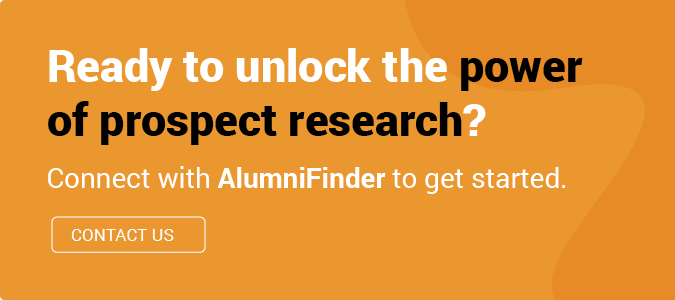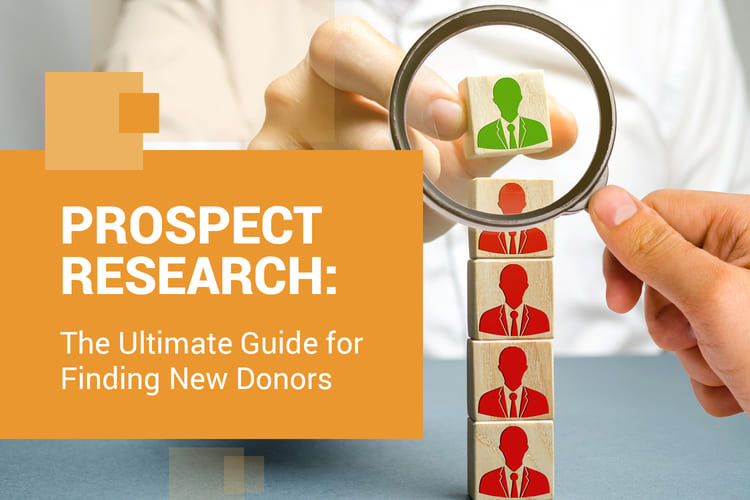
Donations are essential for keeping nonprofits and higher education institutions afloat. From funding a building expansion to supporting the launch of a new program, strategic fundraising will help your organization thrive now and in the future. But to be successful, you need to know who to solicit support from. That’s where prospect research comes into play.
Donor prospect research is the process of researching and evaluating potential donors according to their capacity and affinity to give. By conducting prospect research, you can make better-informed decisions about how to optimize your appeals. In this guide, we’ll explore everything you need to know about prospecting, including:
- FAQs About Prospect Research
- Data Collected Through Prospect Research
- 4 Strategies for Conducting Prospect Research
Ready to learn how prospect research can support your nonprofit or school’s fundraising efforts? Let’s address some common questions about the process.
FAQs About Prospect Research
What is donor prospect research?
Prospect research is a technique that fundraisers use to evaluate a potential donor’s capacity and desire to give. It involves gathering and assessing donor demographics, community involvement history, charitable giving patterns, wealth markers, business affiliations, and other important information.
With these key insights, your organization can make informed decisions about which prospects to pursue and how best to solicit their support.
What is the difference between prospecting and wealth screening?
Prospect research and wealth screening are valuable tools that nonprofits use to identify potential donors. The main difference between the two is the intent of the research.
Wealth screening is narrowly focused on the financial aspects of a donor’s profile—such as real estate ownership, stock ownership, and political giving.
Prospect research, on the other hand, is more comprehensive and detailed. It takes into account a donor’s background, philanthropic history, charitable giving patterns, and any financial information. Gathering as much information as you can about a potential donor will set your outreach and cultivation strategies up for success.
What are the benefits of prospect research?
Prospect research allows nonprofits and higher education institutions to focus their efforts on people who are most likely to give. As such, it supports your larger fundraising efforts by allowing you to: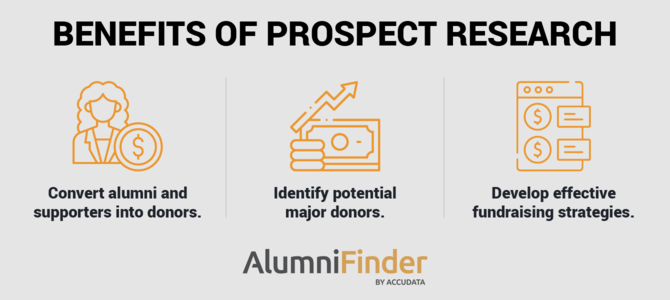
- Convert alumni and supporters into donors. For colleges and universities, chances are your graduates have become successful biologists, writers, farmers, professional athletes, and more. For nonprofits, you may have email subscribers or social media followers who are ready to take the next step in their involvement with your organization. Use prospect research to identify those who have the greatest capacity to give and the desire to see your organization thrive.
- Identify potential major donors. The most common use of prospect research is to discover major donors. For most fundraising campaigns, the majority of money raised comes from a small number of generous donors. Prospect research can help you find the people who are most likely to make a significant donation to your nonprofit or institution.
- Develop effective fundraising strategies. Prospect research can help your organization understand donor demographics, interests, and giving patterns. You can use this information to tailor messaging and optimize fundraising campaigns.
By identifying and engaging prospective donors, you’ll be able to attract and direct resources across important funding priorities, such as operational costs, programming, and outreach.
Data Collected Through Prospect Research
Prospect research goes a step beyond wealth screening by determining a potential donor’s capacity and affinity to give. To do so, it’s important to collect both philanthropic and wealth data, which we’ll differentiate below.
Wealth Data
An individual’s capacity to give is dependent on financial information, such as: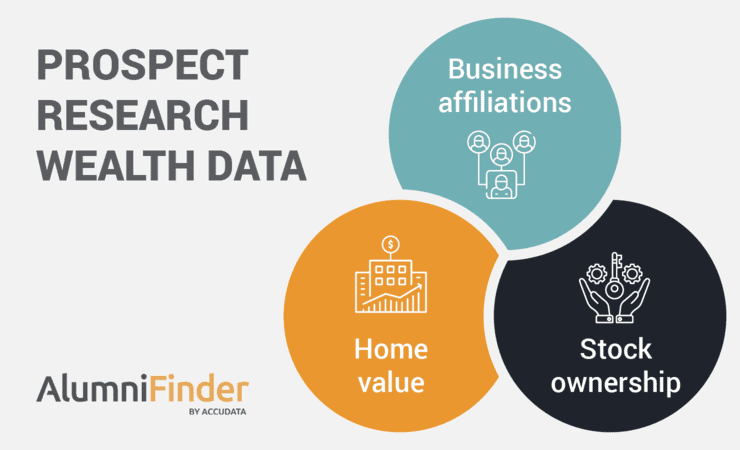
- Business affiliations: Estimate a potential donor’s financial situation by reviewing their employment history and salaries.
- Stock ownership: A donor’s stock ownership can indicate their relative wealth and ability to give, but it can also be a method of giving. As a registered 501(c)(3), you can accept donations of stocks in addition to typical cash giving.
- Home value: Real estate ownership can help you determine a potential donor’s net worth. Plus, homeowners with over $2 million in real estate are 17 times more likely to give to charity than the average person.
In collecting this data, you might also screen for indirect wealth indicators, such as age, marital status, and education—all of which can help you better understand someone’s ability to donate.
Philanthropic Data
As crucial as a potential donor’s financial status may be, it’s more powerful when paired with philanthropic data that answers the question: “Would this donor be interested in giving to our institution?”
Collect the following information to gauge a donor’s interest in giving: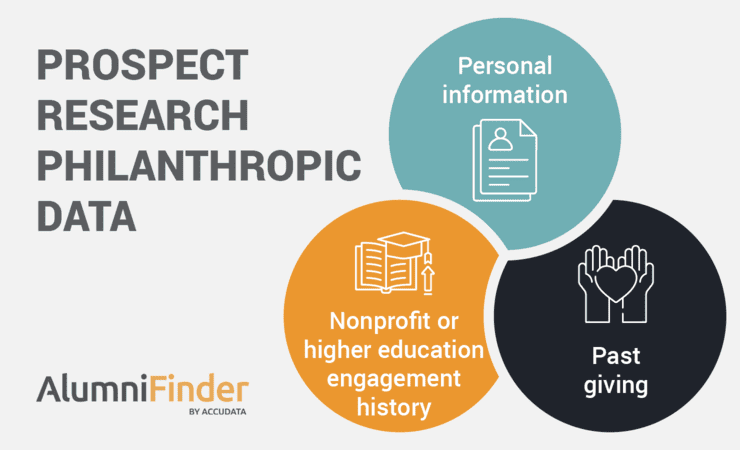
- Personal information: Explore social media profiles and other public records to better understand a person’s hobbies, interests, and values.
- Past giving: Past giving to your nonprofit or institution is one of the best indicators of future giving. Let’s say an alumni donor gave a one-time, $5,000 donation to your school after graduation. Since they already helped to further your cause, you have a strong case for soliciting larger, more frequent gifts from them. Giving to other nonprofits or higher education organizations can also help identify philanthropic-minded donors who would likely connect with your mission.
- Nonprofit or higher education engagement history: Explore a potential donor’s engagement history with your organization or another nonprofit or higher education institution. For instance, have they volunteered, served on a board, or taken another action that indicates an investment in your cause?
Assessing this data helps to ensure that a prospective donor will resonate with your mission and respond positively to your appeals. Ideally, you want to target donors who have a passion for philanthropy as well as significant wealth.
However, depending on your fundraising goals, you may adjust this focus. For instance, while searching for ideal donors to support your on-campus art museum’s peer-to-peer fundraising campaign, you may focus on recent art school graduates who have less income but a stronger connection to your cause.
4 Best Practices for Conducting Prospect Research
Before you dive into prospect research, it’s important to have a clear strategy in place to guide your efforts. We recommend following these four best practices: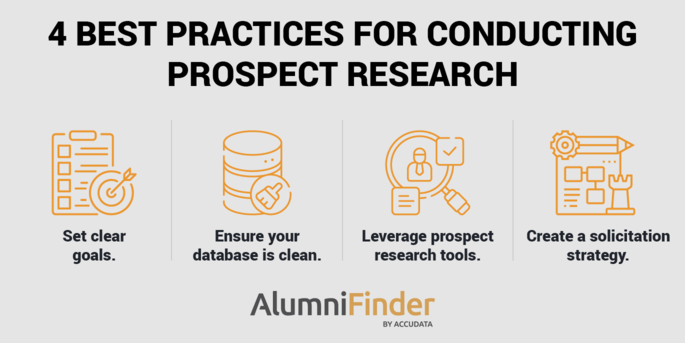
1. Set clear goals.
Prospect research can support a variety of fundraising efforts and can be conducted on an ongoing basis. However, it’s more effective when tied to a specific goal.
Common prospecting goals include:
- Uncovering major donors within a pre-existing donor pool.
- Identifying new potential donors who may be interested in giving.
- Understanding donor motivations and behaviors for improved outreach.
Setting clear goals at the beginning of the process allows you to get as much value out of prospecting as possible.
Use these objectives to guide your efforts, but be open to revising them according to your campaign needs. For instance, if you’re entering the quiet phase of a capital campaign, you should focus your efforts on identifying major donors, since large gifts are much needed during this time. Then, as you move into the public phase, you can shift your attention to learning about smaller donor preferences and soliciting their support.
2. Ensure your database is clean.
Clean data is fundamental to prospect research. When you have an updated and organized database, you can easily use it to identify current donors who have the propensity to increase their level of giving or lapsed donors who have the desire to recommit to your cause.
Partnering with a data hygiene service provider like AlumniFinder will help streamline the prospecting process by:
- Removing duplicate information.
- Updating outdated or missing wealth and philanthropic data.
- Standardizing data entries to mitigate error.
- Suppressing individuals you don’t want to receive your appeal, such as those who don’t seem likely to give.
Once your database is clean, assign team members to conduct prospect research on donors in the system. When they come across someone with a high propensity to give, have them create a donor prospect profile containing relevant information gathered during the prospect screening process, such as capacity and affinity data and any other details that would be beneficial for outreach. This will help your office track, sort, evaluate, and solicit each prospect.
3. Leverage prospect research tools.
Prospect research can be challenging for organizations just starting with the process. Thankfully, there are prospect research tools and services to support your efforts.
To flesh out your donor prospect profiles, you can:
- Search through public records. If you’re a small college or university with a tight budget, you might benefit from conducting research yourself using free tools like SEC and FEC filings. These public records include financial data like stockholder information, business value, and political contributions. Nonprofits can also use public social media profiles and Candid, a free nonprofit directory, to see if their prospects are philanthropically minded.
- Conduct a data append. Whether you’re missing key philanthropic and wealth information about prospects or you want to better understand your current donors, data appends are the answer. With a data append, you can update existing information and add new data to your database, empowering your fundraising efforts.
- Partner with a prospect research expert. Ensure a profitable and effective prospecting experience by investing in experienced prospect researchers. At AlumniFinder, we help higher education fundraisers find and attract new donors. With more than 400 vendor partners, we have the most extensive prospect data collection available. And, it has been proven to drive stronger fundraising results.
- Invest in matching gifts automation. Matching gift databases with auto-submission can be used to identify which donors and prospects are eligible for matching gifts, a type of philanthropy in which companies financially match donations that their employees make to philanthropic causes. This type of tool will help you make more personalized asks and solicit higher levels of giving.
Bringing together the best tools and data provides powerful insights that allow you to make more informed decisions about your nonprofit or higher education fundraising strategy.
4. Create a solicitation strategy.
Once you determine who your prospects are, it’s time to solicit their support. For the most effective ask, be sure to:
- Use their preferred communication channel.
- Personalize your outreach by addressing them by name and mentioning their past involvement or other interests.
- Ask for a specific amount based on their financial status and past giving.
- Share more information about your cause and fundraising needs.
As you reach out and develop stronger relationships with prospects, track additional information in your donor prospect profiles such as meeting notes, communication responses, and expressed interest in a certain initiative. Not only does this keep your records up to date, but it also helps you optimize your cultivation and stewardship strategies.
Want to learn more about soliticing major gifts? Check out our guide!
Prospect research can have a huge impact on the size of your donor base, helping to drive organizational growth and support your mission. Remember to take a holistic approach that combines both capacity and affinity insights to gain a more comprehensive view of your prospects. With these tips and tools, you can identify and engage donors who will support your nonprofit or educational institution well into the future.
If you’re interested in learning more about prospect research and how data can support your strategy, explore these additional resources:
- Higher Education Marketing Strategies to Help You Boost Enrollment. Learn how to engage prospective students and recent alums in your future fundraising efforts.
- Tools for the 21st Century: A Modern Fundraiser’s Success Kit. Take your prospect research data to the next level with the tools and strategies suggested in this in-depth kit.
- Enhance Supporter Data. Explore how data enhancement and data enrichment can support the prospecting process.

